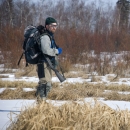Monitoring
Beginning in 1968, and every five years since 1975, the U.S. Fish and Wildlife Service has been performing aerial censuses of interior Alaska's summering (presumably) Trumpeter Swan population. Kanuti Refuge has participated in the census since 1985. From 1990–2020, swan pairs in the Refuge have increased 657%. A recent supplemental nest survey suggests that 95% of Kanuti’s swan pairs are now Trumpeters (up from ~60% Trumpeters circa 1990). Kanuti’s breeding Tundra Swan populations appeared to have changed little between 1990 and 2020.





